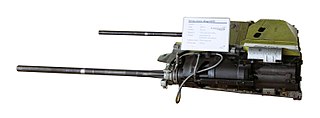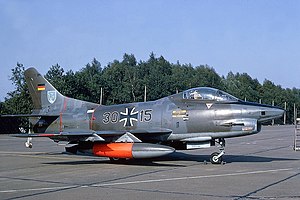Dassault Aviation SA is a French manufacturer of military aircraft and business jets. It was founded in 1929 by Marcel Bloch as Société des Avions Marcel Bloch or "MB". After World War II, Marcel Bloch changed his name to Marcel Dassault, and the name of the company was changed to Avions Marcel Dassault on 20 January 1947.

In current military parlance, a strike fighter is a multirole combat aircraft designed to operate both as an attack aircraft and as an air superiority fighter. As a category, it is distinct from fighter-bombers. It is closely related to the concept of interdictor aircraft, but it puts more emphasis on aerial combat capabilities as a multirole combat aircraft. Examples of contemporary American strike fighters are the McDonnell Douglas F-15E Strike Eagle, Boeing F/A-18E/F Super Hornet, and Lockheed Martin F-35 Lightning II.

The Fiat G.91 is an Italian jet fighter aircraft designed and built by Fiat Aviazione, which later merged into Aeritalia. The G.91 has its origins in the NATO-organised NBMR-1 competition in 1953, which sought a light fighter-bomber to be adopted as standard equipment across the air forces of the various NATO nations. After reviewing multiple submissions, the G.91 was picked as the winning design of the NBMR-1 competition.

The Dassault Étendard IV is a transonic carrier-borne strike fighter aircraft developed and manufactured by French aerospace company Dassault Aviation.

The Dassault-Breguet Super Étendard is a French carrier-borne strike fighter aircraft designed by Dassault-Breguet for service with the French Navy.

The Dassault Étendard II was a French prototype fighter aircraft initially developed as a follow-on project to the Dassault Mystère series. It was presented to the French Air Force for evaluation but was rejected in favour of the Dassault Mirage III.
The Dassault Étendard VI was a French prototype fighter aircraft initially developed as part of the NATO NBMR-1 competition to find a standard fighter to serve amongst member air forces. Dassault took advantage of the fact that the French Air Force had issued a requirement around the same time for a new fighter-bomber and developed aircraft in parallel as variations of the same design concept for the two prospective customers.
French aircraft manufacturer Dassault used the name Étendard for a family of related aircraft projects beginning in the late 1950s. Versions that at least reached prototype stage were:

The DEFA cannon is a family of widely-used French-made aircraft revolver cannon firing 30 mm caliber NATO standard rounds.
The Société des Ateliers d'Aviation Louis Bréguet also known as Bréguet Aviation was a French aircraft manufacturer.

The Snecma Atar is a French axial-flow turbojet engine built by Snecma. It was derived from the German World War II BMW 018 design, and developed by ex-BMW engineers through a progression of more powerful models. The name is derived from its original design group, Atelier technique aéronautique de Rickenbach near Lindau within the French Occupation Zone of Germany. The Atar powered many of the French post-war jet aircraft, including the Vautour, Étendard and Super Étendard, Super Mystère and several models of the Mirage.

The Dassault Mirage IIIV, also spelled Mirage III V, was a French vertical take-off and landing (VTOL) prototype fighter aircraft of the mid-1960s developed and produced by Dassault Aviation.

The Bristol Siddeley Orpheus is a single-spool turbojet developed by Bristol Siddeley for various light fighter/trainer applications such as the Folland Gnat and the Fiat G.91. Later, the Orpheus formed the core of the first Bristol Pegasus vectored thrust turbofan used in the Harrier family.

The SNEB rocket is an unguided air-to-surface 68 mm (2.7 in) rocket projectile manufactured by the French company TDA Armements, designed for launch by attack aircraft and helicopters. It is also known as the SNEB rocket pod, and sometimes as the Matra rocket, due to its commonly being carried in pod-like launchers built by Matra.

The Bréguet Br.1001 Taon was a 1950s French prototype single-seat jet strike fighter aircraft built by Bréguet.

The SNCASE S.E.5000 Baroudeur was a French single-engined lightweight fighter designed by SNCASE (Sud-Est) for the NATO NBMR-1 "Light Weight Strike Fighter" competition. An unusual design without a conventional landing gear, it used a wheeled trolley for take-off and three retractable skids to land. The Baroudeur did not enter production.

The Martin-Baker Mk.4 is a British ejection seat designed and built by Martin-Baker. Introduced in the 1950s, the Mk.4 has been installed in combat and training aircraft worldwide.

NBMR-3 or NATO Basic Military Requirement 3 was a document produced by a North Atlantic Treaty Organisation (NATO) committee in the early 1960s detailing the specification of future combat aircraft designs. The requirement was for aircraft in two performance groups, supersonic fighter aircraft (NBMR-3a) and subsonic fighter-bomber aircraft (NBMR-3b). Both requirements specifically stated the need for V/STOL performance as the contemporary fear was that airfields could be overrun or disabled through Eastern Bloc hostile actions and that dispersed operating bases would be needed. Germany was planning replacements for the Fiat G.91 and Lockheed F-104G Starfighter using the new aircraft types.

SEPECAT was an Anglo-French aircraft manufacturer. Established during 1966, its aim was to handle the development and commercialization of the Jaguar, an attack and training aircraft. Organised as a Société Anonyme, the company was joint venture between British Aircraft Corporation and Breguet.















